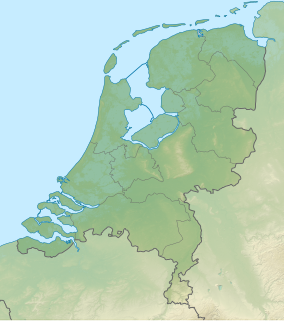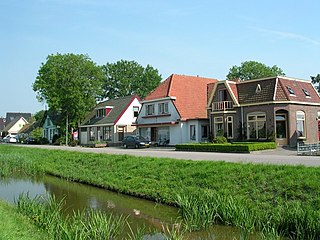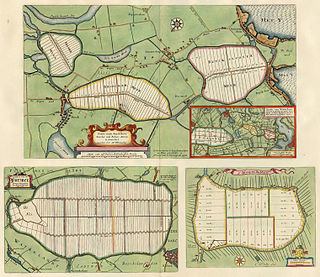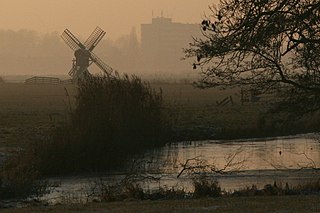
Kinderdijk is a village in the municipality of Molenwaard, in the province of South Holland, Netherlands. It is located about 15 km east of Rotterdam.

Wieringerwaard is a polder and a village in the municipality of Hollands Kroon in the Dutch province of North Holland. Wieringerwaard was formerly a separate municipality, until it merged with Barsingerhorn in 1970.

Wind rights are rights relating to windmills, wind turbines and wind power. Historically in Continental Europe wind rights were manorial rights and obligations relating to the operation and profitability of windmills. In modern times, as wind becomes a more important source of power, rights relating to wind turbines and windmills are sometimes referred to as "wind rights".

Purmer is a polder and reclaimed lake in the Netherlands province of North Holland, located between the towns of Purmerend and Edam-Volendam. Windmill reclamation activity began in 1618. Hydraulic engineer Jan Adriaanszoon Leeghwater also had stakes in the reclamation, although he was not directly involved in the project itself. In 1622 all 26.8 km² were clear of water.

Aylvapoldermolen is a smock mill in Burgwerd, Friesland, Netherlands which has been restored to working order. The mill is listed as a Rijksmonument, number 15626.

The Cornwerdermolen is a smock mill in Cornwerd, Friesland, Netherlands which has been restored to working order. The mill is listed as Rijksmonument number 39329.

Arkens is a Hollow Post mill in Franeker, Friesland, Netherlands which has been restored to working order. The mill is listed as a Rijksmonument, number 15710.

De Oegekloostermolen is a hollow post mill in Hartwerd, Friesland, Netherlands which was built before 1830. The mill has been restored to working order. It is listed as a Rijksmonument, number 39347.

De Volharding is a smock mill in Jislum, Friesland, Netherlands which was built in 1872. The mill has been restored to working order and designated as being held in reserve in times of emergency. It is listed as a Rijksmonument, number 15632.
The city of Leeuwarden, Friesland, the Netherlands has had at least 130 windmills over the centuries. Only one, the Froskepôlemolen survives today within Leeuwarden. Six other mills which have stood in Leeuwarden survive elsewhere in the Netherlands. The mills had a wide range of industrial and agricultural uses. The industrial uses include the processing of bark for tanning leather, the fulling of cloth, the production of cement, the production of dyes, the extraction of oil, the grinding of tobacco to produce snuff, the production of gunpowder, and the sawing of timber. Agricultural uses include the milling of buckwheat, oats, rye and wheat, the processing of chicory, the production of pearl barley, and the pumping of water.

The Terpensmole is a drainage mill in IJlst, Friesland, Netherlands. It was moved from its earlier location in Sneek in 2011 where it was known as the Himmole. The mill is listed as a Rijksmonument, number 22914. It is fully functional and can be used to help drain the adjacent polder.

Terpzigt is a drainage mill in Marssum, Friesland, Netherlands. It is the smallest spinnenkop, a type of hollow post windmill. The mill is listed as a Rijksmonument, number 8625.

The Monnikenburenmolen or Nijhuizumermolen is a drainage mill in Nijhuizum, Friesland, Netherlands. It was restored in 2008 after it was only just saved from demolishment in 1994. It is a hollow post windmill of a type called "spinnenkop" by the Dutch. The mill is listed as a Rijksmonument, number 527646. It can help drain the polder and has been designated as a backup to the pumping station by the waterboard Wetterskip Fryslân.

The Geeuwpoldermolen is a drainage mill near the twin village of Oppenhuizen, Friesland, Netherlands. It is a hollow post windmill of the type called spinnenkop by the Dutch. The mill is listed as a Rijksmonument, number 39810 and it is still in use for draining the Geeuwpolder. It was almost completely renewed at a restoration in 1987, earlier restorations were in 1954 and 1965.

Teetlum, after a nearby terp, also known as Duivenhok 'dove coat' named after the polder it drained, is a drainage mill near the village of Tzum, Friesland, Netherlands. It is a hollow post windmill of the type called spinnenkop by the Dutch. The mill is listed as a Rijksmonument, number 15877 and can be used to drain the adjacent polder.

The spinnenkop of the Netherlands Open Air Museum in Arnhem is a small drainage mill originally located near Gorredijk, Friesland, Netherlands. It is a hollow post windmill that has been restored to working order.

The windmills at Kinderdijk are a group of 19 monumental windmills in the Alblasserwaard polder, in the province of South Holland, Netherlands. Most of the mills are part of the village of Kinderdijk in the municipality of Molenwaard, and one mill, De Blokker, is part of the municipality of Alblasserdam. Built in 1738 and 1740, to keep water out of the polder, it is the largest concentration of old windmills in the Netherlands and one of the best-known Dutch tourist sites. The mills are listed as national monuments and the entire area is a protected village view since 1993. They have been a UNESCO World Heritage Site since 1997.

De Schalsumermolen is a smock mill in Schalsum, Friesland, Netherlands which was built in 1801. The mill has been restored to working order. Used as a training mill, it is listed as a Rijksmonument.

The smock mill at the Netherlands Open Air Museum, Arnhem, Gelderland, Netherlands was originally built at Noordlaren, Groningen, Netherlands in 1862. It was dismantled in 1953 and re-erected at the museum in 1960. The mill has been restored to working order.

A hollow post mill at the Netherlands Open Air Museum, Arnhem, Gelderland, Netherlands was originally built at Gouda, South Holland, Netherlands. It was dismantled in 1946 and re-erected at the museum. The mill has been restored to working order.





















